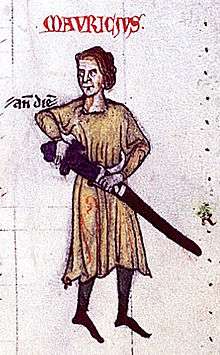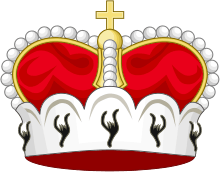Hiberno-Normans

The Hiberno-Normans or Norman Irish are those Normans who settled in Ireland after the Norman conquest of Ireland in 1169 and who remained a distinct community (the Anglo-Irish) until their eclipse in the early 17th century following the Tudor conquest of Ireland. The term embraces both their origins as a distinct community with their own dialect of Norman-French and their development in Ireland (the prefix "Hiberno" means "relating to Ireland or the Irish", from Hibernia). The Clan Burke, FitzGeralds, Butlers and de Berminghams are notable families among them.
The Hiberno-Normans often admitted little if any real fealty to the Anglo-Norman settlers in England,[1] and soon began to interact and intermarry with the Gaelic nobility of Ireland, especially outside the zone of English control known as the Pale. This process of gaelicisation became known as the Hiberno-Normans becoming more Irish than the Irish themselves (Latinised as Hiberniores Ipsis Hibernis).
By the late 16th century, the Hiberno-Normans began to be referred to as the Old English. In the Irish language, while they were known as the gaill or "foreigners", people born in England were called Sasanaigh or "Saxons" and there was a clear distinction made between Gaill and Sasanaigh in the Irish annals.
Hiberno-Norman surnames

The following is a list of Hiberno-Norman surnames, many of them unique to Ireland. For example, the prefix "Fitz" meaning "son of", in surnames like FitzGerald appears most frequently in Hiberno-Norman surnames. (cf. modern French "fils de" with the same meaning).[2] However, very few names with the prefix "Fitz-" sound Norman but are actually of native Gaelic origin; most notably FitzPatrick (from the Mac Giolla Phádraig, kings of Osraige) and FitzDermot (Mac Gilla Mo-Cholmóc, of the Uí Dúnchada sept of the Uí Dúnlainge based at Lyons Hill, Co. Dublin).
- Barrett
- Blake, from de Blaca
- Blanchfield, from De Blancheville
- Bodkin
- Burke, also the variants Bourke, de Búrc, de Búrca and de Burge
- Butler
- D'Alton
- D'Arcy, also the variant De Arcy
- de Barry
- de Clare
- Candon, Condon, from de Caunteton
- Costello
- Cusack, also the variant de Cussac (from Gascony Bordeaux region of France)
- de Lacy
- Delaney
- Dillon (surname), from de Leon
- Devereaux
- Deane, from de Denne
- English
- Fanning
- Finglas
- FitzGerald
- FitzGibbons
- Fitzhenry, also the variant Fitzharris
- Fitzmaurice, also the variant Fitzmorris
- Fitzralph
- Fitzrichard
- FitzRoy
- Fitzsimons/Fitzsimon
- Fitzstephen
- Fitzwilliam
- Hussey (From Houssaye in Seine-Maritime region in Normandy.) Also the variant O'Hosey, Oswell and others
- Harpur
- Joyce
- Jordan
- Kiely, Keily
- Kilcoyne, derived from the original Gaelic "O Cadhain", emerged in Norman Galway.
- Lambart (There is a possible kinship between the Lambarts and Lamberts)
- Lambert, also the variant Lamport. Most notably John Lambert of Creg Clare
- le Gros or later translation, "le Gras" (anglicized "Grace").
- Mansell, from Le Mans, France
- Marren
- Martyn, also the variant Martin
- Mansfield
- Mac Eoin Bissett
- Mee (Anglicized form of Le Mée: habitational name from (Le) Mée in Mayenne, Eure-et-Loir, and Seine-et-Marne) [3]
Mohan (surname) (early descendant)
- Nagle
- Nangle
- Nicolas, Nicola
- Perrin,Perrinne
- Petit, Petitt, Pettit
- Plunkett
- Power (le Poer)
- Prendergast
- Preston
- Redmond
- de Tiúit/Tuite
- Roche (Derived from de Rupe or de la Roche)
- Rossiter (other form to write Rosseter, Rossitur, Raucester, Rawcester, Rochester)
- Russell (Derived from a French term for a red-haired individual.)
- Savage
- Sinnott
- Stack
- Taaffe
- Testard
- Tyrrell or Tyrell
- Tobin
- Wall (Anglicized from Du Val). See academic genealogy text Wall family in Ireland (1170-1970).
- Walshe/Walsh/Welsh (meaning "foreigner" or literally "Welshman". Gaelic Breathnach)
- Woulfe (Anglicized from the Original Norman-Gaelic De Bhulbh [Wolf])
- White/Whitty (Anglicized from the original de Faoite meaning "of fair skin")
Hiberno-Norman texts
The annals of Ireland make a distinction made between Gaill and Sasanaigh. The former were split into Fionnghaill or Dubhghaill, depending upon how much the poet wished to flatter his patron.[4]
There are a number of texts in Hiberno-Norman French, most of them administrative (including commercial) or legal, although there are a few literary works as well.[5][6] There is a large amount of parliamentary legislation, including the famous Statute of Kilkenny and municipal documents.
The major literary text is The Song of Dermot and the Earl, a chanson de geste of 3,458 lines of verse concerning Dermot McMurrough and Richard de Clare, 2nd Earl of Pembroke (known as "Strongbow").[7] Other texts include the Walling of New Ross composed about 1275, and early 14th century poems about the customs of Waterford.
See also
- Later Medieval Ireland (1185 to 1284)
- Tribes of Galway
- Anglo-Norman
- Cambro-Norman
- Insular French
- Irish nobility, which distinguishes three groups of Irish nobility (one of which this article addresses)
- Italo-Norman
- Norman Ireland
- Scoto-Norman
References
- ↑ See, for instance, Robert Dudley-Edwards, Ireland in the Age of the Tudors: The Destruction of Hiberno-Norman Civilization (1977); Gearóid Mac Niocaill The Red Book of the Earls of Kildare (1966);
- ↑ Edward MacLysaght, Guide to Irish Surnames (1965)
- ↑ Genealogy of the Mee Family, 1913, LSFHC Film #0944099 #ID# M/F 46
- ↑ See Art Cosgrove, 'Hiberniores Ipsis Hibernis', Late Medieval Ireland 1370-1541 (Dublin, 1981) for a discussion of the differences between 'Gaill', 'Gaedhil' and 'Saxain' in late medieval Irish identity. Fionnghaill, fair-haired foreigners, were of Norwegian descent; Dubhghaill, dark-haired foreigners, were of Danish descent. The former had longer roots in Ireland and thus was, as Brendan Bradshaw demonstrated, used as a greater compliment. Normans were, of course, originally "men of the North" i.e. from Scandinavia. See CELT (http://www.ucc.ie/celt/publishd.html) for English translations of these distinctions made in all the principal late medieval Irish annals.
- ↑ list of Hiberno-Norman French texts at CELT
- ↑ Bibliography of Hiberno-Norman French at CELT
- ↑ Online text of Song of Dermot and the Earl at CELT
